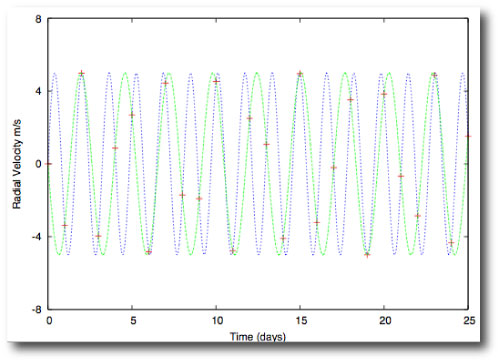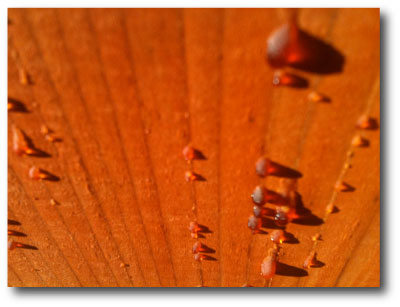It’d be rather unsettling to sit down with a cup of coffee one morning, and learn from astro-ph that the orbital period of Mars is not 1.88 years as is widely believed, but is rather a mere 7.83 months.
Last week, Rebekah Dawson and Dan Fabrycky posted a paper that gave me an equivalent jolt, and which has likely touched off a certain uproar within the planet-hunting community. Their claim is that the periods of a number of A-list planets, including 55 Cnc e and HD 156668 b are in fact aliases, and that the true periods of these worlds are startlingly different. Dawson and Fabrycky argue that the true period of 55 Cnc e is a fleet 0.7365 days (revised from 2.817d), and that HD 156668b orbits with a period of 1.2699 days rather than the published value of 4.6455d. Other well-known worlds may well be in line for a similar treatment.
Sometimes, things seem very clear in retrospect. In the graph just below, I’ve plotted the reflex velocity curves for two planets. One has a period of 1.61803 days, the other has a a period of 2.61803 days. If one happens to observe only at the times when the curves intersect, then it’s clear that there’s no way to tell them apart.

In the particular case above, the intersections of the sinusoids are separated by exactly one day. If the true period of the system is 1.61803 days, then we would say that the 2.61803 day period is an alias produced by the 1-day observing frequency. In general, for an observing frequency, f_o, and a true period, f_t, aliases exist at frequencies f=f_t+m*f_o, where m is an integer.
Aliases are a problem in Doppler surveys because observations are most efficiently done when the star is crossing the meridian, leading to a natural spacing of one sidereal day (23h 56m) between data points. Further periodicities in data-taking arise because RV survey time is usually granted during “bright” time when the Moon is up, and as a consequence of the yearly observing season for non-circumpolar stars. Aliases are minimized when observations are taken randomly, but the nuts and bolts of the celestial cycles impose regularity on the timestamps.
In reducing the period of 55 Cnc e to a sizzling 17.7 hours, the probability that the planet transits is raised to a very respectable 25%. Seems to me like rolling the dice with a few hours of Warm Spitzer time might be in order.


I re-ran my best fit for 55 Cancri as soon as I read the paper a few days ago. With a period for planet e of 0.7365 days the chi^2 for the fit improved from 7.72 to 5.755. I would never have considered going for this shorter period because in the past I have considered very short period eccentric planets as unphysical attempts to tweak the fit.
The paper suggests an eccentricity of 0.17 (although they acknowledge that zero eccentricity doesn’t affect the fit too much). I see a chi^2 of 6.3 for this scenario. I would prefer the zero eccentricity fit personally.
Have to wonder whether any of us involved with systemic would have found this possibility if the console periodograms went below 1 day. Certainly there was quite a lot of effort put into this system when the systemic backend was up.
Pingback: Tweets that mention systemic » de-aliased -- Topsy.com
Fascinating. Perhaps one of the other detection techniques (apart from the transit method) may be used, such as direct imaging – but that’s in years to come – to validate the currently discovered systems…
Diversifying on your comment Andy, during the height of Systemic I actually ‘found’ an object with a period of 0.665d in the residuals periodograms, f-test of 0.0000 for HD64468 (2008), and below the minimum ‘threshold’ of the periodograms. This was then listed on Bruce Gary’s AXA site. However, in retrospect the RV dataset had only 13 observations and it is difficult to judge if there was anything there – probably this was overfitting to a limited dataset.
And now the confirmation that the shorter period for 55 Cnc e is correct: transit detection!